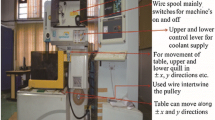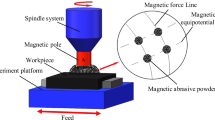Abstract
The process parameters of pulsed tungsten inert gas (PTIG) have a significant influence on the formation quality, mechanical properties and corrosion resistance of the weld overlay. The PTIG was utilized to deposit Inconel 625 clads with various combinations of the process parameters, which were determined by the central composite design (CCD) method. Based on the experimental results, the relationship between process parameters of PTIG and formation quality of the Inconel 625 clads was established using support vector regression (SVR) with different kernel functions, including polynomial kernel function, radial basis function (RBF) kernel function, and sigmoid kernel function. The results indicate that the kernel functions have a great influence on the prediction of height, width and dilution. The models with RBF kernel function feature the best goodness of fitting and the most accurate against the other SVR models for estimating the height and the dilution. However, the model with polynomial kernel function is superior to the other SVR models for predicting the width. Meanwhile, the prediction performance of the SVR models was compared with the general regression analysis. The results demonstrate that the optimized SVR model is much better than the general regression model in the prediction performance.
Similar content being viewed by others
References
SILVA C C, DE MIRANDA H C, MOTTA M F, et al. New insight on the solidification path of an alloy 625 weld overlay [J]. Journal of Materials Research and Technology, 2013, 2(3): 228–237.
GUO L L, ZHENG H L, LI Y Q, et al. Microstructure and performance of Inconel 625 cladding deposited by hot wire pulsed TIG [J]. China Surface Engineering, 2016, 29(2): 77–84 (in Chinese).
DINDA G P, DASGUPTA A K, MAZUMDER J. Laser aided direct metal deposition of Inconel 625 super-alloy: Microstructural evolution and thermal stability [J]. Materials Science and Engineering: A, 2009, 509(1/2): 98–104.
XING X X, DI X J, WANG B S. The effect of post-weld heat treatment temperature on the microstructure of Inconel 625 deposited metal [J]. Journal of Alloys and Compounds, 2014, 593: 110–116.
GUO L L, ZHENG H L, LIU S H, et al. Formation quality optimization and corrosion performance of Inconel 625 weld overlay using hot wire pulsed TIG [J]. Rare Metal Materials and Engineering, 2016, 45(9): 2219–2226.
ABIOYE T E, MCCARTNEY D G, CLARE A T. Laser cladding of Inconel 625 wire for corrosion protection [J]. Journal of Materials Processing Technology, 2015, 217: 232–240.
RAJANI H R Z, MOUSAVI S A A A, SANI F M. Comparison of corrosion behavior between fusion cladded and explosive cladded Inconel 625/plain carbon steel bimetal plates [J]. Materials and Design, 2013, 43: 467–474.
KIM J S, PARK Y I, LEE H W. Effects of heat input on the pitting resistance of Inconel 625 welds by overlay welding [J]. Metals and Materials International, 2015, 21(2): 350–355.
DUPONT J N. Solidification of an Alloy 625 weld overlay [J]. Metallurgical and Materials Transactions A, 1996, 27(11): 3612–3620.
ABIOYETE, FOLKES J, CLAREAT. A parametric study of Inconel 625 wire laser deposition [J]. Journal of Materials Processing Technology, 2013, 213(12): 2145–2151.
KIM J S, LEE H W. A study on effect of intergranular corrosion by heat input on Inconel 625 overlay weld metal [J]. International Journal of Electrochemical Science, 2015, 10(8): 6454–6464.
LIANG E B, HU S S, WANG Z J. Optimization of GTAW cladding process of Inconel 625 on carbon steel using response surface methodology [J]. Transactions of the China Welding Institution, 2016, 37(6): 85–88 (in Chinese).
KUMAR T S, BALASUBRAMANIAN V, SANAVULLAH M Y. Influences of pulsed current tungsten inert gas welding parameters on the tensile properties of AA 6061 aluminium alloy [J]. Materials and Design, 2007, 28(7): 2080–2092.
GUO L L, HE Y T, JU L Y, et al. Progress in additive manufacturing technique based on pulsed TIG [J]. Journal of Materials Engineering, 2018, 46(12): 10–17 (in Chinese).
MADADI F, ASHRAFIZADEH F, SHAMANIAN M. Optimization of pulsed TIG cladding process of stellite alloy on carbon steel using RSM [J]. Journal of Alloys and Compounds, 2012, 510(1): 71–77.
GHOSH P K, KUMAR R. Surface modification of micro-alloyed high-strength low-alloy steel by controlled TIG arcing process [J]. Metallurgical and Materials Transactions A, 2015, 46(2): 831–842.
GUO L L, ZHENG H L, LIU S H, et al. Effect of heat treatment temperatures on microstructure and corrosion properties of Inconel 625 weld overlay deposited by PTIG [J]. International Journal of Electrochemical Science, 2016, 11(7): 5507–5519.
QI B J, YANG M X, CONG B Q, et al. The effect of arc behavior on weld geometry by high-frequency pulse GTAW process with 0Cr18Ni9Ti stainless steel [J]. The International Journal of Advanced Manufacturing Technology, 2013, 66: 1545–1553.
WEN P, FENG Z H, ZHENG S Q. Formation quality optimization of laser hot wire cladding for repairing martensite precipitation hardening stainless steel [J]. Optics and Laser Technology, 2015, 65: 180–188.
SHAHI A S, PANDEY S. Modelling of the effects of welding conditions on dilution of stainless steel claddings produced by gas metal arc welding procedures [J]. Journal of Materials Processing Technology, 2008, 196(1/2/3): 339–344.
PETKOVIC D. Prediction of laser welding quality by computational intelligence approaches [J]. Optik, 2017, 140: 597–600.
ALAMANIOTIS M, MATHEW J, CHRONEOS A, et al. Probabilistic kernel machines for predictive monitoring of weld residual stress in energy systems [J]. Engineering Applications of Artificial Intelligence, 2018, 71: 138–154.
ZHANG Z F, ZHONG J Y, CHEN Y X, et al. Feature extraction and modeling of welding quality monitoring in pulsed gas touch argon welding based on arc voltage signal [J]. Journal of Shanghai Jiao Tong University (Science), 2014, 19(1): 11–16.
YOUSEFIEH M, SHAMANIAN M, SAATCHI A. Optimization of experimental conditions of the pulsed current GTAW parameters for mechanical properties of SDSS UNS S32760 welds based on the Taguchi design method [J]. Journal of Materials Engineering and Performance, 2012, 21(9): 1978–1988.
GIRIDHARAN P K, MURUGAN N. Optimization of pulsed GTA welding process parameters for the welding of AISI 304L stainless steel sheets [J]. The International Journal of Advanced Manufacturing Technology, 2009, 40: 478–489.
BABU S, KUMAR T S, BALASUBRAMANIAN V. Optimizing pulsed current gas tungsten arc welding parameters of AA6061 aluminium alloy using Hooke and Jeeves algorithm [J]. Transactions of Nonferrous Metals Society of China, 2008, 18(5):1028–1036.
GOMES J H F, PAIVA A P, COSTA S C, et al. Weighted Multivariate Mean Square Error for processes optimization: A case study on flux-cored arc welding for stainless steel claddings [J]. European Journal of Operational Research, 2013, 226(3): 522–535.
DAS B, PAL S, BAG S. Torque based defect detection and weld quality modelling in friction stir welding process [J]. Journal of Manufacturing Processes, 2017, 27: 8–17.
HUANG X X, SHI F H, GU W, et al. SVM-based fuzzy rules acquisition system for pulsed GTAW process [J]. Engineering Applications of Artificial Intelligence, 2009, 22(8): 1245–1255.
DAS B, PAL S, BAG S. A combined wavelet packet and Hilbert-Huang transform for defect detection and modelling of weld strength in friction stir welding process [J]. Journal of Manufacturing Processes, 2016, 22: 260–268.
KOO Y D, YOO K H, NA M G. Estimation of residual stress in welding of dissimilar metals at nuclear power plants using cascaded support vector regression [J]. Nuclear Engineering and Technology, 2017, 49(4): 817–824.
CORTES C, VAPNIK V. Support-vector networks [J]. Machine Learning, 1995, 20(3): 273–297.
EDWIN RAJA DHAS J, KUMANAN S. Evolutionary fuzzy SVR modeling of weld residual stress [J]. Applied Soft Computing, 2016, 42: 423–430.
MA H B, WEI S C, LIN T, et al. Mixed logical dynamical model for back bead width prediction of pulsed GTAW process with misalignment [J]. Journal of Materials Processing Technology, 2010, 210(14): 2036–2044.
PAI P F, HONG W C. Software reliability forecasting by support vector machines with simulated annealing algorithms [J]. Journal of Systems and Software, 2006, 79(6): 747–755.
PAI P F. System reliability forecasting by support vector machines with genetic algorithms [J]. Mathematical and Computer Modelling, 2006, 43(3/4): 262–274.
KEERTHI S S, LIN C J. Asymptotic behaviors of support vector machines with Gaussian kernel [J]. Neural Computation, 2003, 15(7): 1667–1689.
EL-ABBASY M S, SENOUCI A, ZAYED T, et al. Artificial neural network models for predicting condition of offshore oil and gas pipelines [J]. Automation in Construction, 2014, 45: 50–65.
KARTHIKEYAN R, BALASUBRAMANIAN V. Predictions of the optimized friction stir spot welding process parameters for joining AA2024 aluminum alloy using RSM [J]. The International Journal of Advanced Manufacturing Technology, 2010, 51: 173–183.
Author information
Authors and Affiliations
Corresponding author
Additional information
Foundation item: the Natural Science Basic Research Plan in Shaanxi Province of China (Nos. 2020JQ-780 and 2017JQ5106), the Open Foundation of Chongqing Engineering Technology Research Center for Light Alloy Materials and Processing (No. GCZX202001), and the Young Teacher Research Project of Xi’an Shiyou University (No. 0104-134010025)
Rights and permissions
About this article
Cite this article
Guo, L., Wu, Z., He, Y. et al. Prediction of Formation Quality of Inconel 625 Clads Using Support Vector Regression. J. Shanghai Jiaotong Univ. (Sci.) 25, 746–754 (2020). https://doi.org/10.1007/s12204-020-2225-9
Received:
Published:
Issue Date:
DOI: https://doi.org/10.1007/s12204-020-2225-9
Key words
- pulsed tungsten inert gas (PTIG)
- Inconel 625
- formation quality
- prediction
- support vector regression (SVR)




